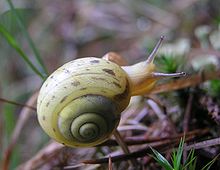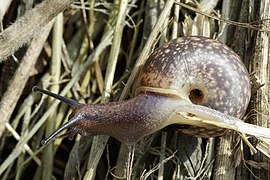| Fruticicola fruticum | |
|---|---|

| |
| Scientific classification | |
| Domain: | Eukaryota |
| Kingdom: | Animalia |
| Phylum: | Mollusca |
| Class: | Gastropoda |
| Subclass: | Heterobranchia |
| Order: | Stylommatophora |
| Family: | Camaenidae |
| Subfamily: | Bradybaeninae |
| Tribe: | Bradybaenini |
| Genus: | Fruticicola |
| Species: | F. fruticum
|
| Binomial name | |
| Fruticicola fruticum (O. F. Müller, 1774)[2]
| |
| Synonyms | |
| |
Fruticicola fruticum is a species of medium-sized, air-breathing land snail, a terrestrial pulmonate gastropod mollusc in the family Camaenidae.[1][3]
Shell description[edit]
The shell of this species is globular with a deep umbilicus. The shell color is whitish or brownish.
The maximum shell dimension is about 22 millimetres (0.87 in).
-
Shell
-
The umbilicus
Distribution[edit]
Europe (until recently including the southeastern part of British Isles, where it was probably introduced.)
- Austria[4]
- Bulgaria
- Czech Republic - least concern (LC)[5][6]
- Germany[7][8]
- Great Britain - extinct[9]
- Netherlands
- Poland
- Serbia
- Finland
- Slovakia
- Ukraine[10]
Life cycle[edit]
The size of the egg is 1.9 millimetres (0.075 in).[11]
This species of snail makes and uses love darts during mating.
References[edit]
- ^ a b Neubert, E. (2011). "Fruticicola fruticum". IUCN Red List of Threatened Species. 2011: e.T156843A5006075. doi:10.2305/IUCN.UK.2011-1.RLTS.T156843A5006075.en. Retrieved 17 August 2023.
- ^ Müller O. F. 1774. Vermivm terrestrium et fluviatilium, seu animalium infusoriorum, helminthicorum, et testaceorum, non marinorum, succincta historia. Volumen alterum. pp. I-XXVI [= 1-36], 1-214, [1-10]. Havniae & Lipsiae. (Heineck & Faber).
- ^ Bieler R, Bouchet P, Gofas S, Marshall B, Rosenberg G, La Perna R, Neubauer TA, Sartori AF, Schneider S, Vos C, ter Poorten JJ, Taylor J, Dijkstra H, Finn J, Bank R, Neubert E, Moretzsohn F, Faber M, Houart R, Picton B, Garcia-Alvarez O (eds.). "Fruticicola fruticum (Müller, 1774)". MolluscaBase. World Register of Marine Species. Retrieved 17 August 2023.
- ^ Wolfgang Fischer (October 24, 2005). "Letzte Änderung am". Vienna. Retrieved April 13, 2007.
- ^ Juřičková L., Horsák M. & Beran L., 2001: Check-list of the molluscs (Mollusca) of the Czech Republic. Acta Soc. Zool. Bohem., 65: 25-40.
- ^ Check-list of the molluscs (Mollusca) of the Czech Republic Retrieved April 13, 2007
- ^ Jürgen H. Jungbluth. "Deutsche Namen für einheimische Schnecken und Muscheln". Retrieved April 13, 2007.
- ^ MollBase - Fruticicola fruticum - Genabelte Strauchschnecke - Atlas 1991 Retrieved April 13, 2007 (in German)
- ^ Anderson, Roy (2005). "An annotated list of the non-marine molluscs of Britain and Ireland" (PDF). Journal of Conchology. 38 (6): 607–637. ISSN 1753-2205.
- ^ Balashov I. & Gural-Sverlova N. 2012. An annotated checklist of the terrestrial molluscs of Ukraine. Journal of Conchology. 41 (1): 91-109.
- ^ Heller J.: Life History Strategies. in Barker G. M. (ed.): The biology of terrestrial molluscs. CABI Publishing, Oxon, UK, 2001, ISBN 0-85199-318-4. 1-146, cited page: 428.



Well, that’s interesting to know that Psilotum nudum are known as whisk ferns. Psilotum nudum is the commoner species of the two. While the P. flaccidum is a rare species and is found in the tropical islands. Both the species are usually epiphytic in habit and grow upon tree ferns. These species may also be terrestrial and grow in humus or in the crevices of the rocks.
View the detailed Guide of Psilotum nudum: Detailed Study Of Psilotum Nudum (Whisk Fern), Classification, Anatomy, Reproduction